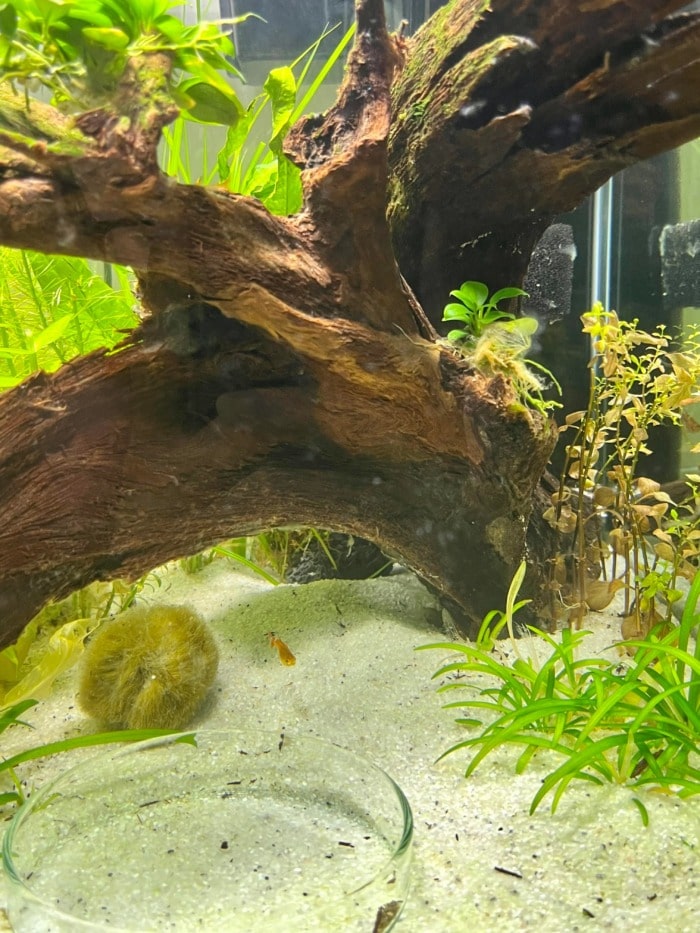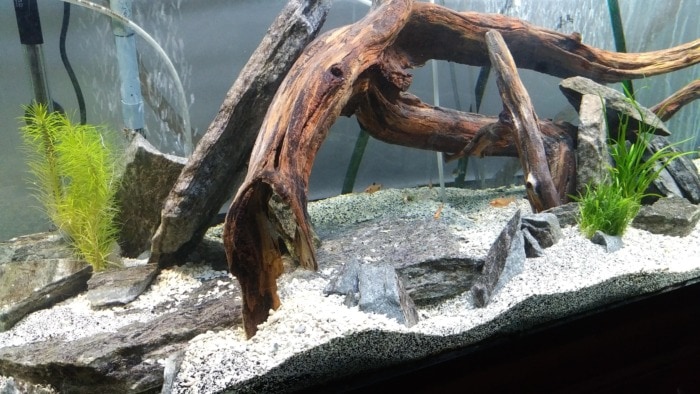Driftwood can add some real character to a fish tank, making the aquascape look really professional. Do you often find yourself wondering where to find driftwood for aquariums in the wild and how safe would that be? Can you obtain it yourself, for free?

Are there types of driftwood that you should avoid while on the lookout for a good fit? Well, I have your answers.
Driftwood is often a centerpiece of stunning aquascape works. I would always try various shapes and sizes, going for that “underwater forest” look. It is also the go-to choice of fishkeepers for a black-watered tank that simulates a tropical river. Needless to say, I have been decorating my tanks with it, for years already.
There are also some fish health benefits to it. Driftwood can potentially lower the high pH value of water, making it ideal for softening the aquarium conditions. This is due to the tannin acids it leaks in the water. These acids have antibacterial properties that are beneficial to your fishes’ immune system.
What exactly is driftwood, though?
Driftwood is not one type of wood, but many. The name is more of a description of where the wood was obtained from. Driftwood is wood that has been washed on the shore of a body of water.
Before we proceed here are some common types of driftwood you should know about:
- African driftwood – a stunning appearance of a hollow wood. Being hollow allows water to enter it fairly easily, making it sink perfectly.
- Malaysian driftwood – Again, really good looking wood. It sinks easily inside a fish tank. If you’re lucky yours may look like the base of a small tree, that you can decorate with other aquatic plants and aquarium moss.
- Savvanah root – A very good addition to any tank as it will sink on its own.
…and many more. I like the shapes that the Manzanita driftwood provides. For my bigger fish tanks, I always try to find my own Madrona driftwood, though.
Anyway, let’s go.
Where to discover some natural driftwood that will work in an aquarium?

A potential search for driftwood in nature will require some legwork or even a vehicle in order to find the right spot.
Here’s where to look for driftwood in the wild:
Ocean beaches with surrounding vegetation, lakes, rivers and creeks are all places where aquarium-grade natural driftwood can be found. You will stand significantly higher chances of finding a piece if you start the lookout immediately after a storm. Begin your expedition no more than 2 to 3 hours after the storm has passed.
If there was no storm lately you can increase your odds by performing a morning search. This is done to get ahead of other driftwood seekers and curious tourists.
My experience has been that the cleanest and most beautiful driftwood can be found for free at the curves of rivers. That’s where most branches will naturally gather.
Can collecting driftwood in nature be illegal?
Some natural parks may be protected by law against collecting natural driftwood.
In such places you could get fined if you get caught taking the branches with you.
Most wildlife preserves and areas will be protected in that regard to some extend, as long as they hold the status of a “preserve”.
I’m saying to an extend, because in places like California for example there are regulations stating that no person can take more than 50 pounds of driftwood from the same park each day.
The reason behind this is that in these areas natural driftwood or bogwood plays a role in the local ecosystem. The branches would typically serve as a home for bugs or birds and other small animals.
Anything public like beaches and forests is usually a safe place to collect natural driftwood freely.
To find out whether an area is protected look up its website or call your local authorities.
Where can you find natural driftwood near your location?
As much as this goes without saying – look at the map! If you’re in a densely populated city, like me, it may take some effort and a car ride to get to the right location. Here’s where to look:
If you’re not fortunate enough to have a body of water nearby, you can try a forest, as driftwood is just any wooden branch that happens to be taken away from its tree by the forces of nature.

by jimmycrackcord
What to look for when searching for driftwood in a forest?
If you’re on the look in the woods know that, generally, hardwood is better than softwood.
Softwoods have too much sap that will eventually create a mess in a fish tank.
Stumbling upon hardwoods that you like the appearance of is not that difficult:
My limited botanical knowledge is that hardwoods are usually broad-leaved trees, where softwoods are the conifers.
You should be looking for hardwoods like balsa, maple, walnut, oak, breech, etc, ideally near the bed of a river. Notable examples of softwoods I can think of are pines, firs, cedar, and redwood.
Bear in mind that searching for the perfect free driftwood piece can be time-consuming.
Some will look better than others.
It would be a wise move to prepare yourself with snacks and water and get a buddy or two.
Think of it as a nice long walk in the great outdoors.
Don’t go for trees that may have been sprayed with pesticides. It’s the reason I am advising you to look for it in the wild.
If you’re certain about the way trees in your backyard have been grown, you can try them as well.
Can you use driftwood from a wild freshwater source like a lake in your fish tank?
Here’s what to know when collecting driftwood that came from a freshwater body of water:
You can use driftwood found in lakes and even swamps, as long as you’re willing to treat them beforehand.
If the tree is still damp, let it dry for a couple of days, to eliminate as many aquatic hitchhikers as possible.
If you don’t have the benefit of a dry sunny day where you live, I can recommend using a fan in the process.
This does not mean, however, that your driftwood is ready. It will need to cure first (more on that below).

by ashbrewer86
Pieces found in lakes and swamps will inevitably need heat treatment.
If the wood has already started to rot, I’d say leave it be.
You can easily recognize a decaying piece of wood.
Try to chop pieces of it with your fingernail.
If that’s enough to break it down, then you know it’s not going to last in your aquarium either.
Mind that freshwater bogwood can be slightly more acidic.
This makes it a perfect choice if you have fish that enjoy soft waters such as the ones in the Amazon river.
Freshwater-found driftwood is a nice candidate for a blackwater fish tank, although that still depends on the type of wood.
Can you use driftwood found around a saltwater source in your aquarium?
Using driftwood found nearby saltwater in the aquarium is actually recommended:
The salt in it has already done half the sterilization for you. Whatever you can find that has been washed on the shore will almost certainly lack fungi. You should still treat and cure such piece of wood as it won’t be entirely free of harmful organisms.
If you happen to find driftwood from an ocean, you’d need to remove the salts.
If you have a dishwasher you can stick it inside and put it to the hottest setting, using no detergents.
Is purchasing driftwood a good idea? Where to buy?
For a 125 gallon tank, say, I’d always choose to go outside and find myself a nice large chunk of driftwood.
However, if you’re an owner of a smaller tank (anything below 75 gallons) it may not be needed.
There are times when I am either too busy or simply too lazy to spend a day looking for a good fit for my aquarium.
These days I prefer to get mine online. Local fish stores sell them too, but the variety is not so great.

by vileseph
If you want to buy yours from a fish store ask if it has been treated.
If you’re lucky it might be. If you have limited access to fish stores, I suggest checking whatever is closeby anyway, before going for the online purchase.
The only resource you could waste is time.
To be fair, there are plenty of online stores that offer driftwood and other aquatic plants for sale.
However, retailers there sell it for home decoration purposes, so it strikes me as a bit overpriced.
Another reason I’m not shopping from them is that the wood itself might be treated with preservation chemicals, which is a big no-no for fish. I don’t usually like taking chances when it comes to an aquarium.
What I do is I go to Amazon, because I know I can find a fairly priced piece there.
There are also reviews, that I can skim through and see what real people like you and I think about a product.
I’m taking the liberty of doing your research for you and showing you what I ended up buying.
It’s this one (link to see it on Amazon). It’s a piece of African Mopani wood.
Note that it’s real wood, meaning that you won’t get what’s on the picture. Shapes will vary.
You can still browse around for a better one though.
Pay attention to the average star ratings and read some reviews!
Reptile tank driftwood may not be suitable for a fish aquarium unless it is announced as such.
When you come to think of it that method is rather cheap, compared to all the effort of finding a nice piece outdoors.
Don’t forget that as with all driftwood, it should be cured before adding it to an aquarium.
How to treat driftwood for a safe aquarium use?

by portabuddy2
Proper preparations of the collected wood are literally vital for a healthy fish tank.
You should assume any driftwood found in nature unsafe for a fish tank prior to treatment. If you don’t take time to treat the wood and prepare it for the tank you risk the lives of your pet fish.
Let me walk you through the process of how I prepare my driftwood before putting it in an aquarium:
- Peel the bark if possible. If you can’t do that yet, get back to this step after executing the next one.
- Boil it. Introducing unknown algae or fungi to my aquarium is the last thing I want. Boiling the driftwood sterilizes it. I boil mine an hour or so. It will release a lot of tannins during the boiling. If it is too large, I try rotating it and boiling its separate parts equally. Which is surely better than nothing.
- Rinse thoroughly and let it dry.
- Clean it with a brush, without using soap or other cleaning detergents. The residue of those will be poisonous to your fish.
- Fill a large container with hot, steaming water. You will use this to soak your driftwood in it. Dechlorinate the water to not let any chlorine get inside your driftwood. You can also use RO/DI or distilled water (I am linking you to a detailed guide I wrote on that).
- Soak it. An essential part of the curing process. You can add 2 pinches of salt to kill any fungi if the piece was not found nearby saltwater. Be sure to fully submerge it. I use a weight of some sort to hold it down. Whatever you choose to hold it down with, it should not be toxic for fish. I use stainless steel, as it is the only metal I’ve found to be safe around fish. Saturating the driftwood with water will allow it to absorb mass. Essentially you want to waterlog it, or in other terms let it cure. You will know it’s ready when it’s hardly trying to float anymore. The larger the piece, the longer it will take to reduce its buoyancy. Smaller pieces will lose theirs completely. Keeping it in the water for about 2 weeks should be enough, but that depends on the type of wood and if you have boiled it prior to the soaking. Boiling will speed the curing process up by a mile. If you know how you’re about to p[osition your piece you can drill small holes in invisible places. This can speed up the curing process.
- Change the water every 2 to 4 days. The water change frequency will vary, depending on how dark it gets. It’s the excess tannins in the wood that are causing that. Tannins are not toxic to fish at all, but they will darken your aquarium water. They will also lower your pH over time. Driftwood is a common method among fishkeepers to regulate high pH levels. Even if that’s your plan you should still let the wooden piece release the excess amounts.
- Let it fully dry. After that, it’s safe to add the wood to your aquarium.
Following these steps, I have been able to use driftwood in almost all of my tanks with no ill effect to my fish for years.
Some people advocate sterilizing it with a 5-10% bleach solution but I’m not a big fan of the idea. And you shouldn’t be either.
Are there issues with aquarium driftwood collected from nature?
I wouldn’t exactly call these issues, but rather inconveniences. Here’s what to watch out for when using driftwood in a fish tank:
- Leaching too many tannins – you can use carbon filter media to filter those out and keep your water clean. If you want to achieve a blackwater aquarium you can skip this step.
- Lowering the pH – Driftwood is great for softwater-loving fish. However, always keep the pH levels in check and stabilize them if needed. Be sure to not cause a violent pH swing as it will harm your fish.
- Floating – This can be a nuisance. Despite curing, larger pieces of driftwood will still try to float. You can anchor them to a heavier slate that you can hide in your substrate. Or you can attach it to rocks. Just don’t use super glue (my article on where you CAN use it) as it will not provide the needed surface coverage. If you’re using bolts be sure they’re made of stainless steel.
My final words
Finding aquarium-safe driftwood on your own is possible, but it’s not always your best option. You know your free time better than me, so that’s up for you to decide. By the way, was this article helpful? Let me know if so.



